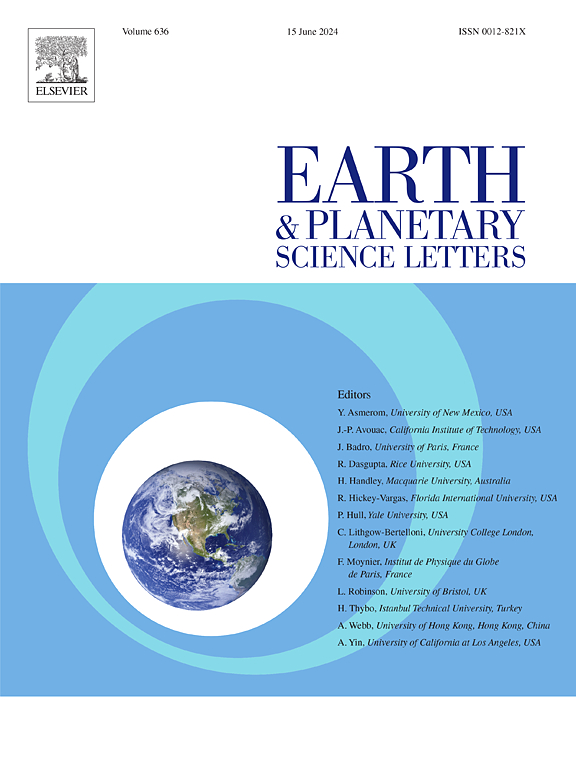同生硅欠饱和和过饱和岩石的岩石成因:地壳同化作用的量化
IF 4.8
1区 地球科学
Q1 GEOCHEMISTRY & GEOPHYSICS
引用次数: 0
摘要
分数结晶过程中的地壳同化通常被认为是一种机制,可以产生进化的硅-过饱和(即石英标准)岩石和共成因硅-不饱和(即长石标准)岩石。然而,所需的同化量和不同结晶参数(如压力、氧逸度)的影响仍然知之甚少,尽管这些同生岩石的岩石成因框架对于理解它们不同的岩浆临界金属富集是必要的。本文应用新的热力学模型,以格陵兰岛南部较年轻的巨型岩脉杂岩为例,定量探讨了这些过程在分馏和同化过程中的作用。探讨了一系列同化情景,以及这些情景的热学和同位素观点。我们的计算表明,相平衡方法可以严格限制同化量(例如,在这个复杂岩体中,0 -≤15%的农村岩石花岗岩的质量同化),因为区分硅不饱和和硅过饱和熔体的成分范围很窄,而热和同位素方法可能允许更大范围的同化估计,因为它们的模型输入参数往往更可变。一般来说,硅不饱和原始熔体在更低的条件和/或更高的压力下结晶,需要更多的地壳同化才能变成硅过饱和。因此,当分馏发生在较低氧逸度和较高压力下时,演化的硅不饱和岩石的形成更有利,因为岩浆更不受同化作用的影响。理解这种行为可能是解释为什么一些碱硅酸盐复合物会产生高浓度的关键金属的重要部分。本文章由计算机程序翻译,如有差异,请以英文原文为准。
Petrogenesis of cogenetic silica-undersaturated and -oversaturated rocks: Quantifying the role of crustal assimilation
Crustal assimilation during fractional crystallisation is commonly proposed as a mechanism to generate evolved silica-oversaturated (i.e. quartz normative) rocks alongside cogenetic silica-undersaturated (i.e. feldspathoid normative) rocks. However, the amount of required assimilation, and the impact of varying crystallisation parameters (e.g. pressure, oxygen fugacity), remain poorly understood, despite a petrogenetic framework for these cogenetic rocks being necessary for understanding their varied magmatic critical metal enrichment. Here we apply new thermodynamic models to a case study of the Younger Giant Dyke Complex in south Greenland, a layered intrusive complex with cogenetic evolved silica-undersaturated and -oversaturated rocks, to explore quantitatively the role of these processes during fractionation and assimilation. A range of assimilation scenarios is explored, alongside thermal and isotopic perspectives on these scenarios. Our calculations show that a phase equilibria approach can tightly constrain assimilant amounts (e.g. 0–≤ 15% assimilation by mass of country rock granite in this complex), because of the narrow compositional range that divides silica-undersaturated from silica-oversaturated melts, whereas thermal and isotopic approaches may permit wider ranges of assimilation estimates because their model input parameters tend to be more variable. In general, silica-undersaturated primitive melts crystallising at more reduced conditions and/or higher pressures require more crustal assimilation to become silica-oversaturated. Consequently, the formation of evolved silica-undersaturated rocks is favoured when fractionation occurs at lower oxygen fugacity and higher pressures, because magmas are more protected from the effects of assimilation. Understanding such behaviour may be an important part of decoding why some alkaline-silicate complexes develop high concentrations of critical metals.
求助全文
通过发布文献求助,成功后即可免费获取论文全文。
去求助
来源期刊

Earth and Planetary Science Letters
地学-地球化学与地球物理
CiteScore
10.30
自引率
5.70%
发文量
475
审稿时长
2.8 months
期刊介绍:
Earth and Planetary Science Letters (EPSL) is a leading journal for researchers across the entire Earth and planetary sciences community. It publishes concise, exciting, high-impact articles ("Letters") of broad interest. Its focus is on physical and chemical processes, the evolution and general properties of the Earth and planets - from their deep interiors to their atmospheres. EPSL also includes a Frontiers section, featuring invited high-profile synthesis articles by leading experts on timely topics to bring cutting-edge research to the wider community.
 求助内容:
求助内容: 应助结果提醒方式:
应助结果提醒方式:


